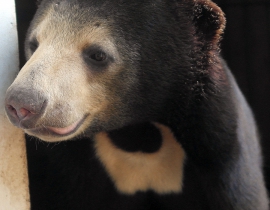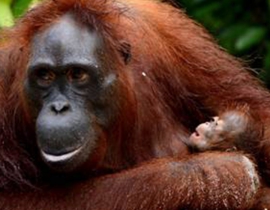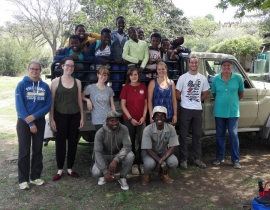Posted May 12, 2017 in All
By Nikki Brown, Presenter and Conservation Assistant at Colchester Zoo between September 2009-January 2014.
The mission of Free the Bears, founded in 1995, is ‘to protect, preserve and enrich the lives of bears throughout the world.’ The Free the Bears Fund provides vital support to many projects worldwide. Today its main focus lies in six priority countries; Cambodia, India, Indonesia, Laos, Thailand and Vietnam. Here it works with the sun bear and Asiatic black bear or moon bear of South-East Asia and the Sloth bear of India. There are many threats that these bear species face, this varies in each country. Dancing bears are a thing of the past in India, thanks to the dedicated work of Free the Bears, however the pet trade and human-bear conflict is still a serious problem. In Vietnam, China and Laos, the bear bile trade is the most serious threat to moon bears, and the greatest challenge the Fund faces is to put an end to this horrible trade. Habitat loss and poaching also threaten the wild bears of Laos. In Cambodia, the smallest of the bear family, the sun bear, is threatened by the pet trade and trade for bear paw soup. In each of these countries there is at least one rescue facility, providing all rescued bears with a much better life. The first sun and moon bear sanctuary was established in Cambodia in 1997. The sanctuary is housed within a zoological garden and rescue centre called Phnom Tamao Wildlife Rescue Centre. This sanctuary provides a unique opportunity allowing volunteers to work alongside these beautiful animals, helping the sanctuary to continue with its vital rescue work and to improve and enrich the lives of all of the rescued bears.
The Cambodian bear sanctuary covers an area of around 8 hectares and currently houses 133 sun and moon bears, all rescued from a variety of situations. There are currently 24 large outdoor enclosures that are divided up into 8 houses and one nursery/quarantine facility. The enclosures are all very natural with rocky outcrops, platforms, pools, native flora, climbing frames and other enrichments. As a volunteer you are supervised and supported by a great team of dedicated and passionate people. These include the amazing keepers who you assist during the placement; Thol one of the volunteer coordinators, who delegates the jobs for volunteers at the centre and always makes you laugh; and Jen the volunteer coordinator, who provides fantastic support for all of the volunteers at the centre, at the volunteer house, and importantly drives us to the centre. She also has the best office with windows looking into the enclosure of some of the younger sun bears; I don’t know how she gets any work done!
During the morning of your first day volunteering, you are given an introduction to Free the Bears and given a tour around the facilities, you also make enrichment to give to some of the houses. In the afternoon you enjoy a tour around Phnom Tamao Wildlife Rescue Centre, a perfect way to get your bearings and view the huge variety of rescued species. The tour around the bear sanctuary lets you meet the dedicated keepers and of course view the bears, and learn more about some of the 133 rescued individuals. A very popular and unique moon bear in House 3 is 22 year old Brandy. She’s housed with 7 other moon bears, but what makes her stand out is her colour. She doesn’t have the usual black fur of a moon bear, instead she is the most beautiful golden colour, and in fact she looks like a lion with darker fur surrounding her face. She was rescued by a local after being found clinging to a tree in a forested area due to be converted to a palm oil plantation. She was kept as a pet until she grew too large and then donated to the sanctuary in 1999. The golden colour is caused by a rare genetic gene. Another unique bear is Tom Tom in House 6 who is a hybrid between a moon and sun bear. He’s as big as a moon bear, but has the short fur and the looks of a sun bear. In House 7, there are 2 female moon bears (Sandy and Rose) and 1 sun bear (Holly) who have lost one their paws to snare traps. This doesn’t stop them from climbing around the enclosure and getting into enrichment. In House 2 there are some big characters, especially in the enclosures that hold some of the younger sun bears; Alfie. Pooh, Soriya, Bearzilla, Zilly and Blue. Soriya is one of the smaller bears, but by no means least she is no way the quietest! These bears are full of energy and love to destroy any logs in their enclosure; even it takes a few weeks to do so!
As a volunteer your day will start by arriving at the centre around 8:30am, this depends on the traffic on the roads from the volunteer house though. Thol will be ready to greet you at House 2 as this has an office and lockers to keep your bags. Once ready Thol informs which houses you can help clean. Volunteers can decide on which house to help clean, thus giving variety on a day to day basis. The houses have 3 or 4 large outdoor enclosures, so cleaning does take up most of the morning. All houses have indoor pens, however the bears are only kept in here during cleaning and scatter feeds, none of the bears are locked up at night. During the morning volunteers help the keepers with giving out breakfast (all bears are excited for this), cleaning the outdoor enclosure (picking up poo and old food), scrubbing pools, hiding food, replacing hammocks, making log piles, raking leaves, removing old enrichment and adding new enrichment (including spraying scents around the enclosure). It does take time to do all of the enclosures as only one enclosure is cleaned at a time, as there are not enough indoor pens for all of the bears. After all the outdoor enclosures have been cleaned and the bears fed, they are then let out back into their outdoor enclosures. The next part is to clean and scrub the indoor pens, and with the keeper you work as a team to do this. Once the indoor area is clean you are done and head to the kitchen. Here you start to chop up the food for tomorrow’s breakfast and today’s scatter feed. There is alot of chopping to be done to feed all 133 bears. Just before lunch volunteers often make enrichment for some of the houses. These will either be boomer balls or pieces of bamboo. These are filled with bananas, green beans, dog biscuits, honey, jam or peanut butter and plugged with morning glory leaves. It’s always wonderful watching the bears enjoy their enrichment, especially when they lie on their backs with the boomer balls over their heads, and use their long tongues to get the food inside.
At 12pm its lunch time and we head to one of the many eating places in the park. For $1 you can enjoy either fried noodles, fried rice, morning glory curry or sweet and sour vegetables. All are very delicious; you can bring your own food as well. After enjoying lunch, volunteers can relax in one of the many comfortable hammocks. You may get some visitors as you relax, including wild pigs and some of the many troops of wild long-tailed macaques, who are looking for food.
After an hour for lunch you head back to the office, afternoon jobs can vary, but usually you will head back to the kitchen to finish chopping the remainder of the food. Once chopped, volunteers can assist with weighing out the food for each enclosure. Every enclosure has weights of food according to how many bears they contain. Each enclosure is colour coded so the food goes into colour coded buckets for keepers to collect or receive. It’s very well organised. Once the kitchen is tidied and enrichment cleaned, other much needed jobs are done by volunteers. This can be making a hammock (a must do for every volunteer), making new enrichment, painting, varnishing or picking up litter. Then from around 3pm, volunteers can then assist with the scatter feeds, again choosing which house they’d like to help out in. This is a great end to the day as you can spend time hiding the food that you prepared in the enclosures, and then watch the bears find it and enjoy it all. At 4pm your day is over and you head back to the volunteer house where you can relax.
This is a daily routine for a Free the Bears’ volunteer. The only extra thing to add is at the end of the week, on a Friday, you will be taken to the nursery house where from outside you can view sun and moon bear cubs and some of the new rescues. Mr Heng the keeper of this house has the best job ever looking after these adorable and playful cubs! It’s a perfect way to end the week and end your time as a volunteer.
Free the Bears are doing the most amazing work and to be able to volunteer at the centre in Cambodia was an absolute privilege. Their work is vital to continue to save SE Asia’s bears. With more and more bears being rescued, more facilities are needed. The Cambodian centre has grown since it opened in 1997 with its current 8 houses, there is no doubt more houses will need to be built in the future. In Laos, Free the Bears are working incredibly hard to stop bear bile farming. Their hard work is paying off with some bile farms closing, however the bears have nowhere to go as the current rescue centre in Laos is full. So currently Free the Bears are working tremendously hard to build a brand new rescue centre, it’s on the way to completion and already 99 moon bears are waiting to move in. This should happen this year, but can’t be done without the kind donations and support of people and zoological collections around the world. To donate, sponsor a bear, become a member and/or volunteer for Free the Bears please visit their website http://www.freethebears.org/
(c) Nikki Acton-Brown
Find out more about volunterring here.



